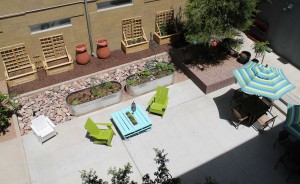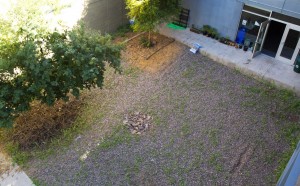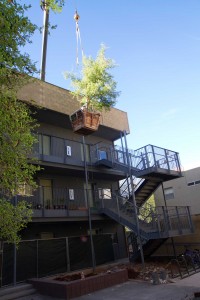May 2, 2014

After a months-long transformation, the School of Sustainability Residential Community's courtyard is an ideal gathering place.
Music, Mexican food, a perfect spring day on a patio in Tempe, Arizona…
This celebration has more of a mission than most, however. In between bites from Chipotle burritos, residents of the School of Sustainability Residential Community (SOSRC) are enthusiastically planting, building and painting. Several Wrigley Sustainability Institute staff members join them, and a butterfly flutters about a fledgling citrus tree as if imitating the activity.
This is the culmination of a months-long effort to recreate SOSRC’s courtyard, located in the appropriately named “S Cluster” of Adelphi Commons II. The colorful umbrellas, numerous planter boxes, plentiful seating and greenery are recent features of a patio that was nothing more than rocks and a French drain prior to the undertaking.

After moving out of the Sustainability House at Barrett, The Honors College last year, School of Sustainability students and staff began searching for something they could call their own. Not only was “S Cluster” within close proximity of their former home, but its potential was immediately recognized.
“As soon as we saw it, we knew it was a diamond in the rough,” says Rebecca Folk, School of Sustainability Residential Community and Events Coordinator. “We saw the possibilities.”
The first step toward making those possibilities a reality was an ideas exchange via “Our Sustainable Dorm” – a private Pinterest board – and SOSRC’s Facebook group page. Residents were encouraged to view the courtyard as their playground and an opportunity to find practical application for classroom concepts. So as a construction crew worked to transform the rock pit into level cement, a vision for a comfortable outdoor space that reflected the principles of sustainability emerged.

“Students began coming to me with ideas,” Folk says. “In most instances, I was able to say, ‘You know what? We can make that happen.’”
It is those ideas that transformed an eyesore into a space that is not only attractive and sustainable, but highly functional. Two rain barrels, which are expected to capture 120 gallons of water previously swallowed by the French drain annually, sit in close proximity to the planter boxes for watering ease. Fresh mulch surrounds the boxes and retains moisture while offsetting heat.
Other notable features are trellises that allow for vertical gardening and a bamboo clothesline that provides a fresh alternative to the dryer. The students have even given new life to old packing pallets, which now function as coffee tables, planters and a means of organizing tools. As Folk says, “It’s all about repurposing.”
How has the new set-up affected residents’ living experience? School of Sustainability students Angela Sese and Hailey Davis agree that the patio has enhanced the sense of community at SOSRC. Both have noticed more socializing among fellow residents now that the indoor lounge is no longer their sole venue for meetings, study sessions, birthday and end-of-semester celebrations, and miscellaneous “hanging out.”
The pleasant outdoor space makes SOSRC an idyllic home and furthers its mission of improving the campus experience by fostering a welcoming learning, living community.
But the “experiment,” as Folk calls it, doesn’t end here. Future plans include climbing vines for further heat mitigation and moisture retention, hanging planters and solar lights on the second story’s balconies, and an increased capacity to house the School of Sustainability’s growing number of students.
The possibilities are certainly palpable at this celebration. As residents hang decorative solar lights from umbrellas and trees, Folk smiles and shares how seeing their imaginations ignite over the re-envisioning of this space has been the project’s greatest reward.
“You can see the sense of accomplishment and empowerment this has given them,” Folk says. “I am honored to be a part of this process. I’ve learned right along with the students.”
To learn more about SOSRC, visit http://schoolofsustainability.asu.edu/resources/residential-life-community.php.

